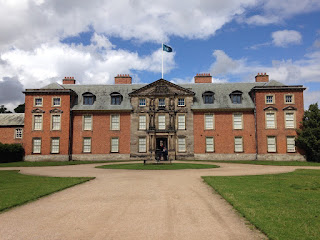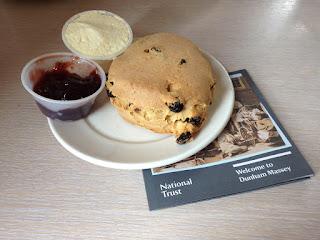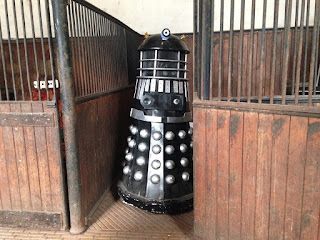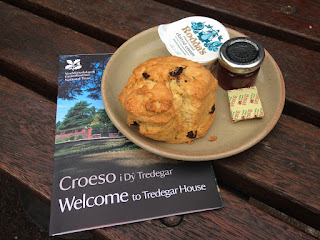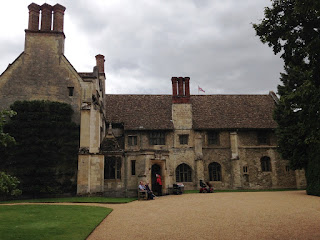For 41 years, I was entirely ignorant of the existence of General James Wolfe. I started reading up on Quebec House in Kent, where he lived until he was 11, and felt the usual sense of failure that I didn't have the faintest idea who he was.
And then IN THE VERY SAME WEEK, I was reading Billy Idol's autobiography and suddenly out of nowhere I found myself reading a paragraph about how he decided to name his son Willem Wolfe...after General James Wolfe!!!! WHAT ARE THE CHANCES OF THAT? And let's face it, when the National Trust aligns with the platinum-haired prince of punk rock, you've got to see it for what it surely is: a sign that you must visit, immediately. So off we went.
The house doesn't open until 1pm but we managed to get on a guided tour that started earlier. Without the tour, I would have spent about 7 minutes wandering around the house looking at muskets before coming away thinking 'that was alright'. With the very excellent tour, I left with a real sense of James Wolfe and the house's history. Here are a few highlights:
The Battle of Quebec
I apologise now to all Canadians, but I had never even heard of the Battle of Quebec. Today I learned that it only lasted 15 minutes in 1759, but it was a pivotal moment in Canadian history. It was fought between the British and French as part of the Seven Years War and it saw the British take control of what had previously been French territory.
Who was General James Wolfe?
James Wolfe had followed his dad into the military at the age of 13. He became famous for his ideas and reforms, both about military strategy and about how officers should treat their men - he even wrote a book on the subject. The Battle of Quebec may have only lasted 15 minutes, but it was long enough for James to be fatally wounded. I found out later that he also fought at the Battle of Culloden, so I hope my dad isn't reading this.
James Wolfe at Quebec House
James was actually born up the road at The Old Vicarage in Westerham, but he grew up at Quebec House. When he was 11, the family moved to Greenwich. However, he was in the army from the age of 13 so the house was very much his formative home.
The Death of General Wolfe Picture
The picture of James Wolfe breathing his last reminded me very much of the one of Nelson doing the same. However, Wolfe's picture came first - it was painted in 1770. The original by Benjamin West is in the National Gallery of Canada, but there are plenty of copies around the house - there's even one on a tea-tray. Jacqui the guide explained that his victory/death was a huge national event and there was all sorts of stuff made to commemorate his achievements, from tea-trays to cups and plates.
Cannonballs
Jacqui pointed out two cannonballs in a display case. They were probably used in the Battle of Quebec, which is interesting enough, but not as interesting as where the National Trust found them: on eBay. And people accuse the Trust of being old-fashioned.
Quebec House Scones
There were no scones at Quebec House but I wasn't surprised by this, for two reasons: a) I've visited 33 properties in 2015 so far and I haven't had a no-scone situation since my trip to Aberdulais Tin Works in January, so I was due a disappointment and b) my fellow National Trust sconeophile, Pete Duxon, had visited Quebec House in February and noted that it was scone-free.
By the way, Pete took some really good photos of Quebec House - you can see them here.
Anyway, the very lovely staff and interesting tour at Quebec House help to offset the lack of scones - it's definitely worth a visit.
Quebec House: 4 out of 5
Scones: 0 out of 5 (there weren't any)
National Trust's eBay ninja skills: 5 out of 5
And then IN THE VERY SAME WEEK, I was reading Billy Idol's autobiography and suddenly out of nowhere I found myself reading a paragraph about how he decided to name his son Willem Wolfe...after General James Wolfe!!!! WHAT ARE THE CHANCES OF THAT? And let's face it, when the National Trust aligns with the platinum-haired prince of punk rock, you've got to see it for what it surely is: a sign that you must visit, immediately. So off we went.
The house doesn't open until 1pm but we managed to get on a guided tour that started earlier. Without the tour, I would have spent about 7 minutes wandering around the house looking at muskets before coming away thinking 'that was alright'. With the very excellent tour, I left with a real sense of James Wolfe and the house's history. Here are a few highlights:
The Battle of Quebec
I apologise now to all Canadians, but I had never even heard of the Battle of Quebec. Today I learned that it only lasted 15 minutes in 1759, but it was a pivotal moment in Canadian history. It was fought between the British and French as part of the Seven Years War and it saw the British take control of what had previously been French territory.
Who was General James Wolfe?
James Wolfe had followed his dad into the military at the age of 13. He became famous for his ideas and reforms, both about military strategy and about how officers should treat their men - he even wrote a book on the subject. The Battle of Quebec may have only lasted 15 minutes, but it was long enough for James to be fatally wounded. I found out later that he also fought at the Battle of Culloden, so I hope my dad isn't reading this.
James Wolfe at Quebec House
James was actually born up the road at The Old Vicarage in Westerham, but he grew up at Quebec House. When he was 11, the family moved to Greenwich. However, he was in the army from the age of 13 so the house was very much his formative home.
The Death of General Wolfe Picture
The picture of James Wolfe breathing his last reminded me very much of the one of Nelson doing the same. However, Wolfe's picture came first - it was painted in 1770. The original by Benjamin West is in the National Gallery of Canada, but there are plenty of copies around the house - there's even one on a tea-tray. Jacqui the guide explained that his victory/death was a huge national event and there was all sorts of stuff made to commemorate his achievements, from tea-trays to cups and plates.
Cannonballs
Jacqui pointed out two cannonballs in a display case. They were probably used in the Battle of Quebec, which is interesting enough, but not as interesting as where the National Trust found them: on eBay. And people accuse the Trust of being old-fashioned.
Quebec House Scones
There were no scones at Quebec House but I wasn't surprised by this, for two reasons: a) I've visited 33 properties in 2015 so far and I haven't had a no-scone situation since my trip to Aberdulais Tin Works in January, so I was due a disappointment and b) my fellow National Trust sconeophile, Pete Duxon, had visited Quebec House in February and noted that it was scone-free.
By the way, Pete took some really good photos of Quebec House - you can see them here.
Anyway, the very lovely staff and interesting tour at Quebec House help to offset the lack of scones - it's definitely worth a visit.
Quebec House: 4 out of 5
Scones: 0 out of 5 (there weren't any)
National Trust's eBay ninja skills: 5 out of 5







